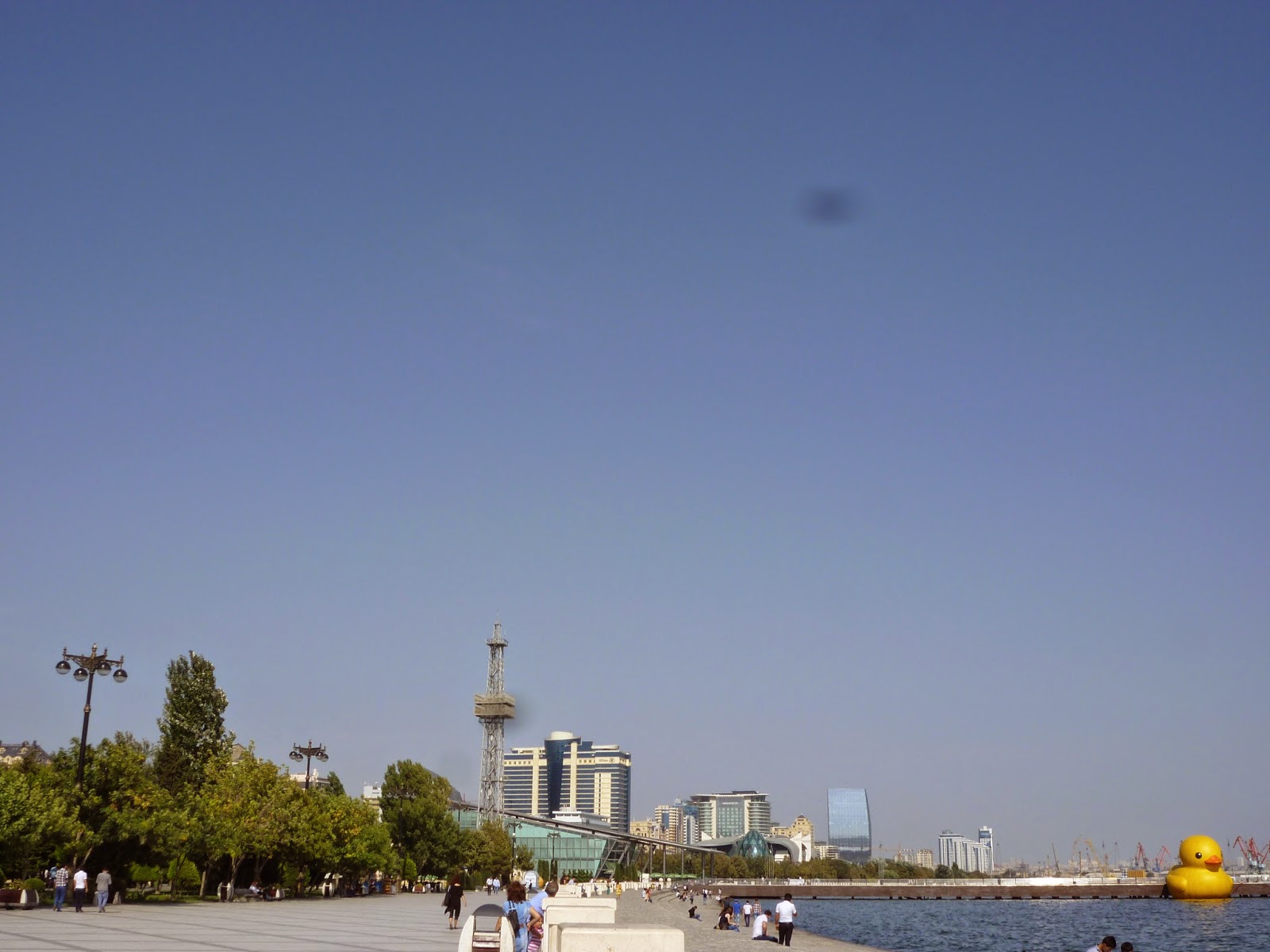After a nice long walk we drive on to find the mud volcanoes. One has to more or less know where they are as there are no real signs. There are quite some visitors, even a bus full of tourists who found their way here anyway. The cool mud sputters up in these small volcanoes and presumably has healing powers. Some people fill big bottles with the grey fluid to take it home with them.
The last days of my trip I spend discovering Baku on my own during the day and seeing some places with my friend in the evening when she is home from work.
The first thing to strike me about this city even on the walk home from the station and then when we drove out of the city to Qobustan and continues to do so basically after every corner is how HUGE many man made things are. In many ways that is also what matters about them. Like the flag behind the bay, it was the biggest national flag, flying from the highest pole - now, sadly, surpassed by Turkmenistan.
The bay from upstairs...
...and Crystal Palace (where the European Song Contest was held)
and the flag seen from a boat
Also by looking at the sprouting architecture I gather that there are huge amounts of money in one hand spending it on one single building complex. How many hands, however, do have money to spend and how many don't is a different question.
Downtown Baku,including the vast promenade at the sea, has an air of a capacious living room, probably also because it's always warm, but not unbearably hot. Well tended parks and squares are decorated with fountains, colorful lights, works of art and different flowers and a lot of life takes place just there for better off people, streets and squares always lively, but never bustling, never squeezing people together.
The duck visiting at the promenade as part of an international arts project
It also is full of Ali and Nino, the couple featured by the moving statues in Batumi. Their story set just before the dawning of Bolshevik rule over Azerbaijan, it is nearly 100 years old and some features of the plot and the circumstances seem quite archaic, but I think in other ways it is a quite timeless example of how a bi-cultural marriage may have you reflect upon your own identity and what is really indispensable to you on the one hand and what may enrich your life on the other hand way more than most couples of a common background. Bookshops, cafés and flower shops call themselves or some offer or project after these two young people whose story is recognized as one of the most important pieces of literature to this country. It is not, however, clear who really wrote it. Kurban Said was a pseudonym, probably of Kiev-born Jewish writer Lev Nussimbaum who grew up in Baku until his family fled from the Bolsheviks. He then lived in Germany where he converted to Islam and published in German, mainly on topics related to the Caucasus. Ali and Nino was first published in 1937 in Vienna - in German. Some researchers support the notion of Yusif Vazir Chamanzaminli's family who claim the Azeri writer who was killed in a Gulag in 1943 wrote at least the core plot of Ali and Nino. As a third party Austrian barronness Elfriede Ehrenfels claims at least co-authorship. It seems unlikely, though, that she contributed to the work itself. She allegedly registered as the contracting author after 1938 as a Jew, converted or not, would not have been able to receive payments for literary work under German rule.
Whoever wrote it, it's well worth reading in my opinion.
Modern buildings just made huge in order to look more impressive and in the process discarding of old living quarters are one part of the story - which isn't widely told. On the other hand big money also goes to museums and other cultural institutions like the new carpet museum. I got to see a part of the carpet exhibition in its old home, along with detailed explanation by a well informed young guide. Some buildings do tell of some imagination on part of their inventors, even though they impress me more by their uniqueness than with their beauty...
Flame Towers in action: Blazing fire...
...and waving flags
When I take the very modern funicular up to the Alley of Martyrs I see that national memory is also no matter to save money. The gleaming graves of the men and women who died fighting for Azerbaijan's independence seem to make it easier for me as an outsider to grasp the scale of that event.
The old town, however, shows that things used to be much smaller, though carefully designed. One of the biggest buildings here is the Maiden Tower, one of the city's landmarks. It is under renovation just now so I cannot visit, but I spend a long time at the Palace of the Shirvanshahs. Built by the ruling dynasty after having transferred the capital of Azerbaijan to Baku there is still some dispute if it was really the palace or mainly a burial site and spiritual center.




















Keine Kommentare:
Kommentar veröffentlichen